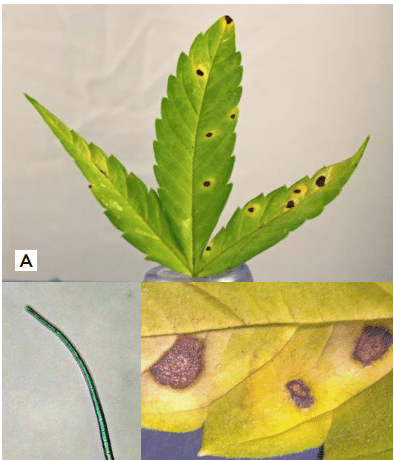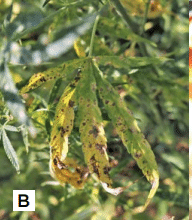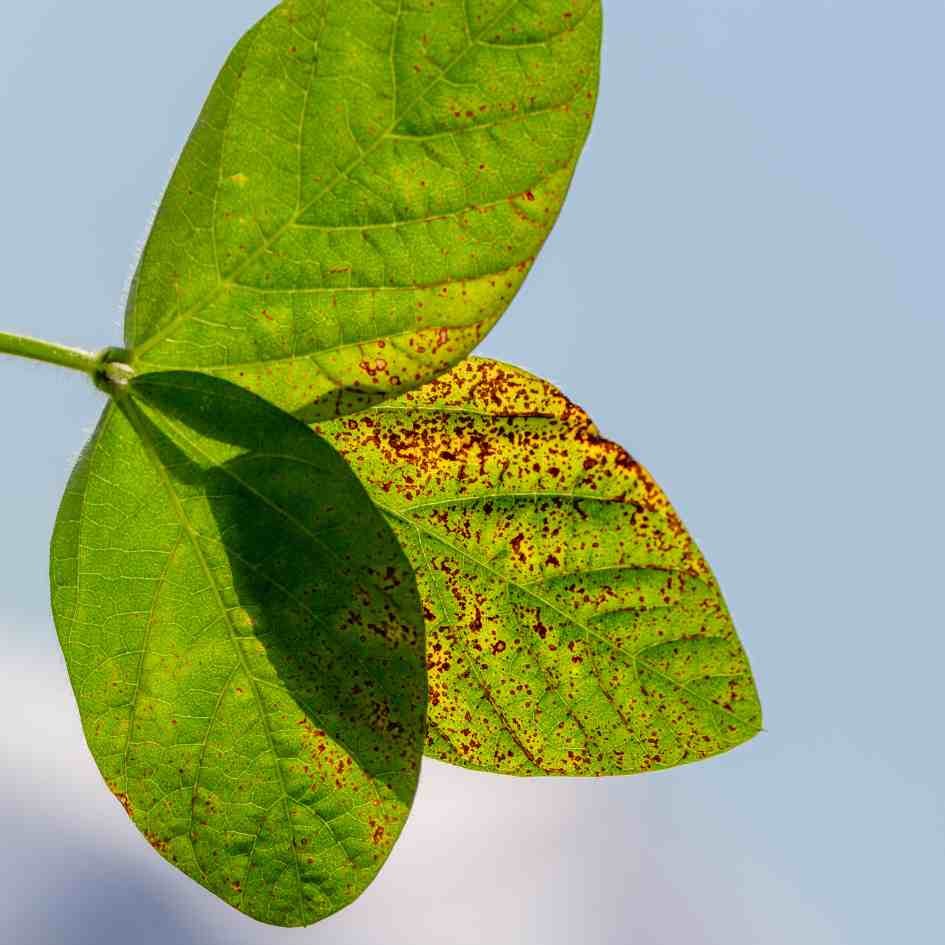Close-up look at brown spots on cannabis plant leaves.
Nothing is more satisfying than seeing our cannabis plants with healthy, bright green leaves. It is a sign of a happy plant that is likely to reward you with a rich, bountiful harvest.
However, despite our meticulous care, some plants can get sick, and signs of an unhappy weed plant are leaf problems.
Leaves often present with yellow, white, brown, and dark spots, or wilting, clusters, and holes, but where do these problems actually come from?
From common diseases and pests to powdery mildew and mould, there are many reasons for leaf problems.
In this blog post, we’ll look at the common causes of leaf problems and what you can do about them!
Key Takeaways
-
Leaf spot diseases became widespread in grow farms in Australia in 2018 and 2019.
-
Southern blight has been the most damaging disease in cannabis production in recent years.
-
Powdery mildew is often a problem on hemp grown in protected cultures such as greenhouses.
-
Fusarium wilt and crown rot of hemp may be caused by several fungal pathogens in the genus Fusarium.
-
Managing the crop environment can reduce cannabis leaf disease by making conditions less favourable for diseases and spread.
-
When common practices fail to provide adequate disease management, fungicides can be used to protect crops from disease.
How to Identify Common Cannabis Leaf Problems
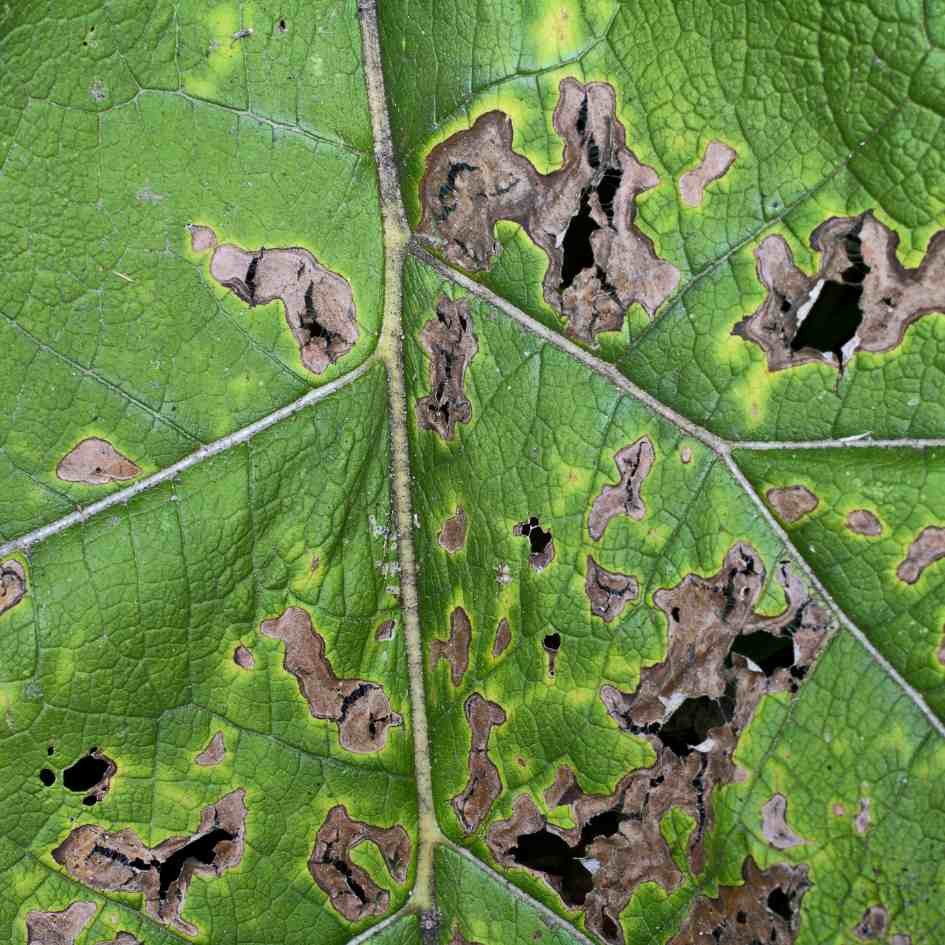
Leaf spots: shapeless, discoloured spots on cannabis plant leaves
Let’s start with how to identify the problems in the first place. Thankfully, leaf problems are easy to identify, especially if you get into the routine of inspecting your plants regularly. Here are some common leaf problems and what you can do to address them.
|
Disease/Pest |
Symptoms |
|
Leaf Spot Diseases |
You may notice small circular lesions with tan centres and brown margins to larger lesions with dark centres and brown/purple margins. Lesions may coalesce, causing blighting to large portions of the leaf area. Leaves may turn yellow and premature defoliation may occur under severe infections. |
|
Southern Blight |
The most common sign of southern blight is dramatic wilting that does not improve following watering. Wilt may come with leaf yellowing, or you may notice white fungal growth at the base of the plant near the soil line and small, round, tan/brown balls called sclerotia, resembling mustard seeds embedded in the white fungal growth. |
|
Hemp Rust |
Yellow/orange spots on the leaf surface, eventually clusters (pustules) of orange spores (uredospores), become visible to the naked eye on the leaf underside. Lesions eventually become dark orange/brown and may coalesce. |
|
Powdery Mildew |
White, powdery fungal growth on the upper leaf surface. Symptoms may also include leaf distortion, necrosis, and premature defoliation. |
|
Fusarium Wilt and Fusarium Crown Rot |
The plant may show wilting that does not recover after watering. The stem tissue near the soil line shows brown discolouration if cut lengthwise, rather than the white of healthy stem tissue. |
|
Damping-off |
A pathogenic fungi that kills seedlings. The plant may show wilt, a brown lesion near the soil line, and roots may show brown discolouration. |
|
Nematodes on Hemp |
You may notice signs of wilting, slow growth, and reduced yield due to interruption of nutrient flow between roots and leaves. Development of small, hard, white galls on the roots, each of which normally contains a single female. |
|
Mites |
Infestations can reduce the plant’s ability to thrive, and severe infestations may cause premature defoliation, stunting, and plant death. Look out for discolouration of leaves with a greyish, yellowing, or bronzing. Silk webbing is often seen where large populations of two-spotted spider mites are present. |
|
Aphids |
Can be found on the undersides of leaves and stems. They produce a sugary waste known as honeydew. Large infestations will result in shiny and sticky leaves from the accumulation of honeydew, and sooty mould may grow on the honeydew. |
|
Corn Earworm |
Larvae chow on the buds, causing considerable injury and the accumulation of frass (worm poop). |
|
Other Common Arthropods Found in Hemp |
Thrips injury can stunt hemp plants and reduce vigour under greenhouse conditions. |
-
Leaf Spot Diseases
Leaf spot diseases occasionally occur today in farms in Australia, particularly in outdoor farms.
Several fungal pathogens may be associated with cannabis leaf spot diseases, including Bipolaris spp. and Cercospora spp.
The symptoms of leaf spot diseases on your plants can range from small circular lesions with tan centres and brown margins to larger lesions with dark centers and brown/purple margins.
These lesions may grow together and cause blighting to large portions of the leaf area. You may also notice your plant leaves turn yellow and premature defoliation may occur under severe infections.
Photo collage of cannabis leaves with yellow spots.
-
Southern Blight
Southern blight has been the most damaging disease in cannabis production across the country in recent years. The disease is caused by the soilborne fungus Athelia rolfsii (also called Sclerotium rolfsii).
The most obvious symptom of southern blight is significant wilting that does not improve after watering. Wilt may be associated with leaf yellowing, infections are often sporadic within a field, and affected plants may be surrounded by healthy plants.
Affected plants show white fungal growth, easily seen with the naked eye, at the base of the plant near the soil line. Small, round, tan/brown balls, called sclerotia, resembling mustard seeds, will be embedded in the white fungal growth.
The white fungal growth and sclerotia may extend beyond the plant stem to the surrounding area on the soil’s surface.
This disease is more prevalent if you have low soil pH. Hemp plants are susceptible at any age, from seedling to full maturity. Once a plant becomes infected with southern blight, there is no cure.
Cannabis plant leaves wilting
-
Hemp Rust
Hemp rust is a fungal disease caused by Uredo kriegeriana. Symptoms of hemp rust begin as yellow/orange spots on the leaf surface, and eventually clusters (pustules) of orange spores (uredospores) become visible to the naked eye on the leaf underside.
Lesions on your cannabis plant leaves eventually become dark orange/brown and may blend.
-
Powdery Mildew
This is also one of the most common, if not THE most common, cannabis leaf problems we’ve seen here in all our years of growing weed. Powdery mildew is a foliar disease, which is a disorder that specifically affects the leaves, caused by the fungal pathogen Golovinomyces cichoracearum.
As the name implies, the most obvious symptom of powdery mildew is white, powdery fungal growth on the upper leaf surface. Symptoms may also include leaf distortion, necrosis, and premature defoliation.
-
Fusarium Wilt and Fusarium Crown Rot
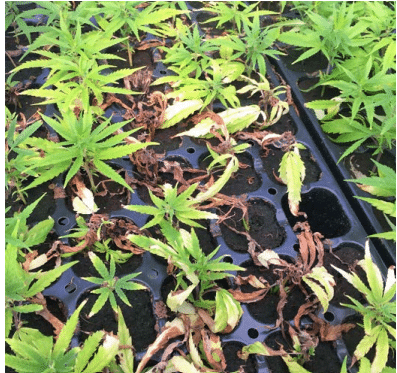
Fusarium wilt and crown rot are characterised by wilting that does not recover even after watering. If you’ve tried to water your plants to fight wilt and still come back empty, your leaves might be attacked by the pathogens that cause the Fusarium wilt.
Fusarium wilt and crown rot of cannabis may be caused by several fungal pathogens in the genus Fusarium. You’ll notice that the stem tissue near the soil line shows brown discolouration if cut lengthwise rather than the white colour of the healthy stem tissue.
-
Damping-off
Damping off has been observed on greenhouse-grown cannabis seedlings and clones. This disease kills seedlings and is caused by several fungi and oomycetes (fungi-like organisms called water moulds), including Rhizoctonia and Pythium. This is a root disease but it all starts with the leaves.
Before seedling death, it’s common for your plant to show wilt, a brown lesion near the soil line, and roots may also show brown discolouration.
-
Mites
The two-spotted spider mite (Tetranychus urticae) and the eriophyid hemp russet mite (Aculops cannibicola) can both cause injury and, in some cases, plant death in both indoor and outdoor grows.
Mites are extremely small and may not be visible without magnification help. Infestations can reduce your plant’s ability to thrive, and severe infestations may cause premature defoliation, stunting, and plant death.
They feed on all plant structures but are most commonly found on the undersides of leaves. Feeding often results in a discolouration of leaves, with a greyish, yellowing, or bronzing effect.
3 leaves undergoing yellowing
Silk webbing is often seen where large populations of two-spotted spider mites are present.
-
Aphids
Like mites, aphids are considered indirect pests of hemp by generally reducing the health of your cannabis plants. They typically are found on the undersides of leaves and stems, where they feed on the phloem (sap) of plants.
As they feed, they produce a sugary waste known as honeydew. Large infestations will result in shiny and sticky leaves from the accumulation of honeydew, and sooty mould may grow on the honeydew.
Ladybirds, natural predators of aphids, are a common biological solution for aphids.
Ladybird, Coccinella septempunctata predatory on aphids.
-
Corn Earworm
The corn earworm (Helicoverpa zea) is a caterpillar that is commonly found feeding on buds and may be the most important pest of cannabis grown outdoors.
Moths are attracted to plants as the buds are developing, and thus, the corn earworm is a late-season pest of hemp grown for seed or CBD production. Larvae eat the buds, causing considerable injury and the accumulation of frass (worm faeces).
-
Other Common Arthropods Found in Hemp
Closeup of spider mite insects on cannabis plant leaves.
You might notice a few species of thrips (Thysanoptera: Thripidae) on cannabis throughout the season. These tiny insects can be serious pests, especially during the seedling stage. They feed on the plant’s sap and introduce viruses, causing the plant stunted growth, deformities, and discolouration.
Treatment and Prevention of Identified Leaf Problems
Healthy plants that are fed and watered well are more resilient to leaf problems than stressed-out plants. Good plant disease management habits will take care of many problems!
Keys to Integrated Cannabis Disease Management
The cannabis disease triangle is a concept related to plant disease management. The triangle comprises a susceptible host, a virulent or infectious pathogen, and an environment favourable for disease development. If all three factors are present at the same time, your risk of a plant disease rises.
You can manage the disease by controlling these factors and, with good habits, managing the risk.
-
Disease-Resistant Cultivars
Choosing disease-resistant cultivars is one of the best ways to manage cannabis plant diseases.
A cultivar is a “cultivated variety” of cannabis that consists of plants that have been selected or bred by plant breeders for specific characteristics.
-
Start with top-quality seeds that have a proven track record of being disease-resistant.
-
Select cultivars with good CBD yield and low-to-moderate leaf spot susceptibility.
-
Simply record observations of diseases and pests along with cultivar information to help decide on future cultivar selections.
-
Pathogens
Limiting pathogen spread can slow the rate of disease development. Start with disease-free transplants or seeds from a trusted source. Australia’s top growers trust us at AussieHempSeeds for disease-free seeds!
Lacewing larvae and ladybirds can be purchased from several online vendors for release to help control or suppress certain pest populations.
-
Environment
Managing the growing environment can also reduce the risk of diseases and make the conditions unfavourable for infection and spread.
-
Select well-drained sites with good water-holding capacity.
-
Eliminate weedy vegetation that competes with your cannabis plants for nutrients and water.
-
Use drip irrigation rather than overhead.
-
Space plants and orient fields to maximise airflow and rapid drying of foliage.
-
Manage weeds to avoid humid microclimates.
-
Maintain optimal soil pH (between 6 and 7) for overall plant health and avoid conditions that favour the disease, southern blight, which likes low pH levels.
Fungicides
When all else fails, you can use fungicides to rid your plants of diseases. Here are four common fungicides that we’ve used.
|
Trade Name |
EPA Registration Number |
Active Ingredient |
Manufacturer |
Target Activity |
|
Regalia |
84059-3 |
Extract of Reynoutria sachalinensis |
Marrone Bio Innovations |
Fungicide and Fungistat |
|
Amplitude/ Stargus |
84059-28 |
Bacillus amyloliquefaciens strain F727 |
Marrone Bio Innovations |
Fungicide |
|
Exile |
91865-2 |
Potassium Salts of Fatty Acids |
Hawthorne Hydroponics LLC |
Insecticide, Fungicide, and Miticide |
|
Defguard |
91865-3 |
Bacillus amyloliquefaciens strain D747 |
Hawthorne Hydroponics LLC |
Fungicide and Bactericide |
Southern Blight Management
-
Grasses are considered the best crop rotation partners to reduce southern blight, a common disease in Australia. However, some fields that haven’t been used for growing crops or have been used as pasture for a few years before planting hemp have had a lot of southern blight, a plant disease. This shows how hard it can be to stop southern blight by just switching what crops are grown.
-
Diseased plants and the soil immediately around them should be carefully removed to reduce overwintering inoculum, which is disease-causing organisms, like fungi or bacteria, that survive through the winter in plant debris or soil and can infect crops the following season.
Final Thoughts…
Many leaf problems will manifest in signs like yellowing, browning, or spotty leaves, wilting, or holes.
Prevention is always better than cure, and with good disease management habits, you can reduce the risk of diseases in your precious cannabis plants.
Always start with top-quality feminised seeds from trusted seed banks. At AussieHempSeeds, we only have the very best, trusted by Australia’s top growers!


